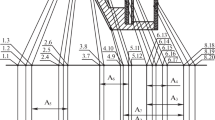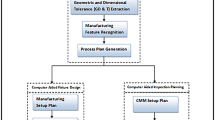Abstract
Conventionally, working dimensions have to be given before the construction of a tolerance chart can begin. Because the method of determining the working dimensions is based on trial and error, it is tedious and time-consuming. This paper proposes a method that can generate the working dimensions automatically from the process sequences and the blueprint dimensions. The method uses a relationship matrix to represent the process sequences and a special path-tracing technique to identify the process links. A unique algorithm is developed to reduce the unknown working dimensions to a system of linear equations, which is then solved using the Gauss elimination technique. This method can either be adopted by the process planner or implemented on a microcomputer. With this method, different processing sequences based on different factors, e.g. cost, machining time, etc., can be evaluated efficiently and economically. The developed program is then tested on a practical example.
Similar content being viewed by others
References
L. E. Farmer and A. G. Harris, “Change of datum of the dimensions on engineering design drawings”,International Journal of Machine Tool Design and Research,24(4), pp. 267–275, 1984.
R. S. Ahluwalia and A. V. Karolin, “CATC — a computer aided tolerance control system”,Journal of Manufacturing Systems,3(2), pp. 153–160, 1986.
D. Fainguelernt, R. Weill and P. Bourdet, “Computer aided tolerancing and dimensioning in process planning”,Annals of the C.I.R.P.,35(1), pp. 381–386, 1986.
P. Bourdet, “Les Chaines de côtes de fabrication”.L'Ingénieur et le Technicien de l'Enseignement Technique, 11/12, 73, N±191, Mai-Juin, 1975.
P. Bourdet, “Cotation de Fabrication”, Cours de l'Ecole Normale Supérieure de l'Enseignement Technique, Cachan, France.
X. Q. Tang and B. J. Davies, “Computer aided dimensional planning”,International Journal of Production Research,26(2), pp. 283–297, 1988.
S. A. Irani, R. O. Mittal and E. A. Lehtihet, “Tolerance chart optimisation”,International Journal of Production Research,27(9), pp. 1531–1552, 1989.
K. Whybrew, G. A. Britton, D. F. Robinson and Y. Sermsuti-Anuwat, “A graph-theoretic approach to tolerance charting”,International Journal of Advanced Manufacturing Technology,5(2), pp. 175–183, 1990.
W. H. Press,Numerical Recipes in C: the Art of Scientific Computing. Cambridge University Press, Cambridge, 1988.
B. K. A. Ngoi, “Applying linear programming to tolerance chart balancing”,International Journal of Advanced Manufacturing Technology,7(4), pp. 187–192, 1992.
Author information
Authors and Affiliations
Rights and permissions
About this article
Cite this article
Ngoi, B.K.A., Teck, O.C. Computer-aided process dimensioning. Int J Adv Manuf Technol 8, 371–376 (1993). https://doi.org/10.1007/BF01751098
Accepted:
Issue Date:
DOI: https://doi.org/10.1007/BF01751098




